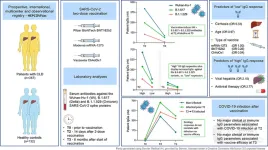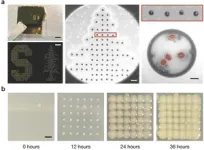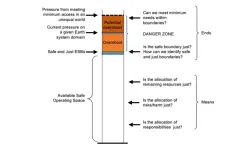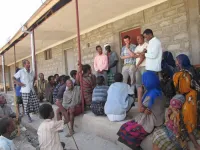(Press-News.org) Amsterdam, March 2, 2023 – The overall responsiveness of patients with chronic liver disease (CLD) to COVID-19 vaccines has been shown to be decreased in patients with cirrhosis. A new prospective study in JHEP Reports, published by Elsevier, now shows that this lower response is observed up to six months following two-dose COVID-19 mRNA vaccination, but it does not reduce vaccine efficacy.
In this prospective study, more than 350 patients with CLD were recruited in clinical centers from Austria, Belgium, Italy, Portugal, Romania, and Spain. Cirrhosis, alongside age and vaccine type, is associated with lower immunoglobulin G (IgG) responses, while the presence of viral hepatitis or antiviral therapy is associated with higher IgG responses. Noteworthy, these differences did not correlate with vaccine efficacy at six months.
Rui Castro, MD, PhD, from the Research Institute for Medicines (iMed.ULisboa), Faculty of Pharmacy, Universidade de Lisboa, Portugal, explained that the consortium behind this study, HEPCOVIVac, “was brought together to create a prospective clinical registry of patients with CLD vaccinated for COVID-19, allowing for comprehensive studies on vaccination safety and efficacy.” The consortium is co-led by Helena Cortez-Pinto, MD, PhD, Centro Hospitalar Universitário Lisboa Norte and Faculty of Medicine, Universidade de Lisboa, Portugal.
Results showed that, among patients with CLD, age, cirrhosis, and type of vaccine were identified as independent predictors of lower immune response, while viral hepatitis, and antiviral therapy stood as independent predictors of higher immune response.
“While the lower response in patients with cirrhosis could relate with cirrhosis-associated immune dysfunction (CAID), and age is already a well-established factor affecting vaccine-mediated immunity, the link between viral hepatitis and higher IgG titers was interesting and warrants further study.” noted Dr. Castro.
When comparing patients who developed COVID-19 between two weeks and six months following vaccination, vaccine efficacy appeared to be slightly lower in patients with higher weight and height. Of note, no correlation was found between the type of vaccine and SARS-CoV-2 infection rates; and no association was found between IgG titers at two weeks and vaccine efficacy. In fact, Wuhan-Hu-1, B.1.617 and B.1.1.529 IgG levels were very similar between SARS-CoV-2 infected and non-infected patients. Results also showed no significant associations between clinical variables and COVID-19 infection rates or infection severity.
“We were surprised by these results, as they suggest that the distinct levels of antibodies induced by the distinct vaccine types, or associated with distinct disease etiology or severity, may not translate into lower vaccine efficacy (COVID-19 infection), at least within the first six months following two-dose vaccination,” noted Dr. Castro. “Although additional studies should ideally be performed, I think this message can already be communicated to patients. That is, that different two-dose mRNA COVID-19 vaccines are effective in a diverse group of patients with CLD. This will help to boost confidence in the vaccination plans put in place by different governments.”
Notwithstanding, results also showed that patient IgG levels against the B.1.617 and, further, the B.1.1.529 variant, were decreased compared with Wuhan-Hu-1, at two weeks following vaccination. This differential pattern was maintained after six months, but with significantly lower antibody titers for all variants, particularly in patients with cirrhosis, in contrast to the results of healthy volunteers.
“These results highlight the need for patients with CLD, particularly those older and with cirrhosis, to receive booster shots” noted Dr. Castro. “Ideally, patients should be prioritized for adapted vaccines against recent omicron variants, although studies on the efficacy of adapted vaccines in patients with CLD are still lacking.”
END
Liver cirrhosis is associated with a lower immune response to COVID-19 vaccines but not with reduced vaccine efficacy
New study of chronic liver disease patients in JHEP Reports shows age, cirrhosis & vaccine type predict “lower” immune response; viral hepatitis etiology & prior antiviral therapy predict “higher” immune response to 2-dose COVID-19 mRNA vaccines
2023-03-02
ELSE PRESS RELEASES FROM THIS DATE:
Human norovirus GII.4 exploits unexpected entry mechanism to cause gastroenteritis
2023-03-02
Human noroviruses are the leading cause of acute gastroenteritis worldwide, a major global health problem for which there are no specific treatments or vaccines. Understanding the first phase of infection – the process the virus follows to invade cells – is a decisive step in the development of effective preventive and therapeutic strategies. A team led by researchers at Baylor College of Medicine is making strides in that direction.
The researchers report in the journal Nature Communications that the globally dominant human norovirus GII.4 strain invades gastrointestinal cells via an unexpected mechanism. The viral strategy involves interactions ...
AI predicts cancer patient survival by reading doctor's notes
2023-03-02
A team of researchers from the University of British Columbia and BC Cancer have developed an artificial intelligence (AI) model that predicts cancer patient survival more accurately and with more readily available data than previous tools.
The model uses natural language processing (NLP) – a branch of AI that understands complex human language – to analyze oncologist notes following a patient’s initial consultation visit—the first step in the cancer journey after diagnosis. By identifying characteristics unique to each ...
For older adults, every 500 additional steps taken daily associated with lower heart risk
2023-03-02
Research Highlights:
A study of people ages 70 and older found walking an additional 500 steps per day, or an additional quarter mile of walking, was associated with a 14% lower risk of heart disease, stroke or heart failure.
Compared to adults who took less than 2,000 steps per day, adults who took about 4,500 steps per day had a 77% lower observed risk of experiencing a cardiovascular event.
Only about 3.5% of participants who took around 4,500 steps per day had a cardiovascular event, compared to 11.5% of those who took less than 2,000 steps per day, over the 3.5-year follow-up period.
Embargoed until 10:45 a.m. CT/11:45 a.m. ET, ...
American Society for Metabolic and Bariatric Surgery supports new clinical guidance on treatment of obesity in children and teens
2023-03-02
The American Society for Metabolic and Bariatric Surgery (ASMBS) fully supports the new “Clinical Practice Guideline for the Evaluation and Treatment of Children and Adolescents With Obesity” issued from the American Academy of Pediatrics (AAP) calling for earlier and more intensive treatment of obesity in children and teens. Published in the journal Pediatrics in February, this is the first comprehensive guideline on obesity in 15 years from the AAP, the largest professional association of pediatricians in the U.S.
According to AAP, more evidence ...
Many firearm owners in the U.S. store at least one gun unlocked, fearing an emergency
2023-03-02
Most firearm owners keep at least one firearm unlocked, with some viewing gun locks as an unnecessary obstacle to quick access in an emergency, according to a Rutgers study. But when they do lock their firearms, Rutgers researchers found that firearm owners are most likely to use gun safes.
In a study published in JAMA Network Open and funded by the Defense Health Agency, researchers surveyed a national sample of 2,152 English-speaking adult firearm owners, asking them what locking devices they used and why.
Unlike previous studies, participants were presented with both words and images describing each ...
To ensure a safe and just future for people, nature and the planet, Earth System Boundaries must include justice, researchers find
2023-03-02
In a new study published in Nature Sustainability an international team of scientists from the Earth Commission, convened by Future Earth, investigates how global biophysical boundaries need to be adjusted to ensure a safe and just future for people, nature and the planet. The Earth Commission is the scientific cornerstone of the Global Commons Alliance
This new framework integrates methods to reduce harm to people, increase access to resources, address tradeoffs, and challenge powerful interests whilst addressing inequality between generations and between humans and nature ...
Genomic study of indigenous Africans paints complex picture of human origins and local adaptation
2023-03-02
Africa, where humans first evolved, today remains a place of remarkable diversity. Diving into that variation, a new analysis of 180 indigenous Africans from a dozen ethnically, culturally, geographically, and linguistically varied populations by an international scientific team offers new insights into human history and biology, and may inform precision medicine approaches of the future.
The work clarifies human migration histories, both historical and more recent, and provides genetic evidence of adaptation to local environments, ...
Energy: More than two million citizens power Europe’s renewable energy transition
2023-03-02
More than two million citizens across 30 European countries have been involved in thousands of projects and initiatives as part of efforts to transition to renewable energy, according to an analysis published in Scientific Reports. With investments ranging between 6.2 and 11.3 billion Euros, these findings highlight the important role of collective action in the decarbonisation of Europe.
The energy system in Europe is undergoing a significant transition towards renewables and decarbonisation. However, the contribution ...
Performance of outpatient surgical procedures before, after onset of pandemic
2023-03-02
About The Study: The findings of this study suggest that despite calls for the expansion of outpatient surgery to mitigate the growing backlog of surgical cases in the wake of the COVID-19 pandemic, uptake of this practice occurred in only a small subset of operations. Further studies should explore potential barriers to the uptake of this approach, particularly for procedures that have been shown to be safe when performed in an outpatient setting.
Authors: Cornelius A. Thiels, D.O., M.B.A., of the Mayo Clinic in Rochester, Minnesota, is the corresponding author
To access the embargoed study: Visit our For The Media website at this link https://media.jamanetwork.com/
(doi:10.1001/jamanetworkopen.2023.1198)
Editor’s ...
Trends, variation in the use of active surveillance for management of low-risk prostate cancer
2023-03-02
About The Study: The results of this study of more than 20,000 men with low-risk prostate cancer suggest that active surveillance rates are rising nationally but are still suboptimal, and wide variation persists across practices and practitioners. Continued progress on this critical quality indicator is essential to minimize overtreatment of low-risk prostate cancer and by extension to improve the benefit-to-harm ratio of national prostate cancer early detection efforts.
Authors: Matthew R. Cooperberg, M.D., M.P.H., of the UCSF Helen Diller Family Comprehensive Cancer Center in San Francisco, is the corresponding ...
LAST 30 PRESS RELEASES:
Making lighter work of calculating fluid and heat flow
Normalizing blood sugar can halve heart attack risk
Lowering blood sugar cuts heart attack risk in people with prediabetes
Study links genetic variants to risk of blinding eye disease in premature infants
Non-opioid ‘pain sponge’ therapy halts cartilage degeneration and relieves chronic pain
AI can pick up cultural values by mimicking how kids learn
China’s ecological redlines offer fast track to 30 x 30 global conservation goal
Invisible indoor threats: emerging household contaminants and their growing risks to human health
Adding antibody treatment to chemo boosts outcomes for children with rare cancer
Germline pathogenic variants among women without a history of breast cancer
Tanning beds triple melanoma risk, potentially causing broad DNA damage
Unique bond identified as key to viral infection speed
Indoor tanning makes youthful skin much older on a genetic level
Mouse model sheds new light on the causes and potential solutions to human GI problems linked to muscular dystrophy
The Journal of Nuclear Medicine ahead-of-print tip sheet: December 12, 2025
Smarter tools for peering into the microscopic world
Applications open for funding to conduct research in the Kinsey Institute archives
Global measure underestimates the severity of food insecurity
Child survivors of critical illness are missing out on timely follow up care
Risk-based vs annual breast cancer screening / the WISDOM randomized clinical trial
University of Toronto launches Electric Vehicle Innovation Ontario to accelerate advanced EV technologies and build Canada’s innovation advantage
Early relapse predicts poor outcomes in aggressive blood cancer
American College of Lifestyle Medicine applauds two CMS models aligned with lifestyle medicine practice and reimbursement
Clinical trial finds cannabis use not a barrier to quitting nicotine vaping
Supplemental nutrition assistance program policies and food insecurity
Switching immune cells to “night mode” could limit damage after a heart attack, study suggests
URI-based Global RIghts Project report spotlights continued troubling trends in worldwide inhumane treatment
Neutrophils are less aggressive at night, explaining why nighttime heart attacks cause less damage than daytime events
Menopausal hormone therapy may not pose breast cancer risk for women with BRCA mutations
Mobile health tool may improve quality of life for adolescent and young adult breast cancer survivors
[Press-News.org] Liver cirrhosis is associated with a lower immune response to COVID-19 vaccines but not with reduced vaccine efficacyNew study of chronic liver disease patients in JHEP Reports shows age, cirrhosis & vaccine type predict “lower” immune response; viral hepatitis etiology & prior antiviral therapy predict “higher” immune response to 2-dose COVID-19 mRNA vaccines



